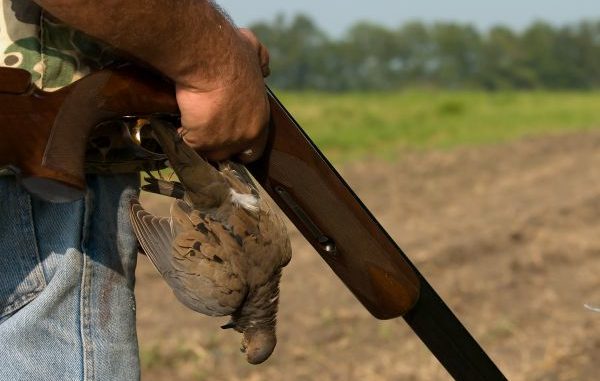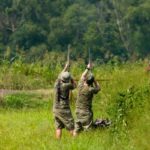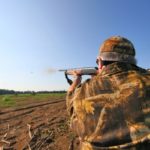
Dove season provides the first taste of fall hunting, and fields will fill with hunters looking to knock the rust off their shooting skills. Here’s why you need to be at your field early and set up wisely.
My brother-in-law jockeyed for position along the line of trucks, ATVs and UTVs lining up down a long gravel driveway beside a farm shed in Tensas Parish.
As we mingled and swapped storied with all the other hunters eager to shoot their guns legally at something for the first time of a new season, he kept his eye on the new arrivals.
“Better watch them,” he whispered under his breath. “I’ve seen guys show up right at the last minute and try to sneak to the front of the line.”
Moments later, I wasn’t sure if folks tried to get to the front of the line to get their pick of a spot to set their shooting stools or to keep from getting blasted by the September sandstorm blowing up from beneath bumpers for as far as the eye could see.
We weren’t first, but we definitely weren’t last, so we hustled over to a spot at the edge of a sunflower field where we spotted a few doves dipping in right above the timber line.
Almost like he was privy to some prior knowledge, my brother-in-law insisted I set up closer to the trees while he walked several yards down the edge of the field away from the trees.
We knew we were legal when our host fired the first shot.
Doves dipped and dove across the field like Black Friday shoppers rushing for bargains just after the doors open.
They were all going somewhere, but they didn’t seem to know where.
Not 1 inch of the field was safe, and the number of flying doves began to drop as more and more of them crumpled and fell from the sky.
After the initial flurry, it become more of a hunt than a shoot.
Some hunters got lucky and had doves fly by every now and then, but my brother-in-law continued to shoot while most of us — well, namely me — could only watch and wonder.
Then it hit me. We were set up at the end of a field where doves were entering to feed.
As they flew over the treetops, they flew right over me just a little bit too high to hit.
Flying with the contour of the land, they fell to within shooting range about 40 yards in front of my brother-in-law.
Seeing as how I was married to his sister, he finally swapped places — but only after his limit-finishing dove hit the ground.
Fortunately for me, there had not been any early season cold fronts blow through to send these resident birds farther south, and enough of them flitted around long enough for me to wrap up a limit of my own.
Anybody who has hunted doves long enough knows that the same fronts they hope for later in the season to bring in more birds can be a nightmare if they roll through before opening day.
Before we could even finish breasting our doves back at the truck, talk had already started about the next day’sshoot. That got me to thinking about something Mike Olinde with the LDWF had recently told me.
“Auburn University did a story relative to fronts,” he said. “What they found was that birds didn’t really just pick up and move wholesale from an area,” Olinde said. “Rather, early in the season, they pick up and disperse within a 15- or 20-mile area.
“They just didn’t suddenly disappear.”
Then I reminded my brother-in-law of something else Olinde told me that seemed to be pertinent to our Sunday shoot.
“We didn’t really shoot them hard,” I said. “If you notice, everybody was done pretty early, and the opening-day pressure didn’t last too long. Seems like everybody got their limits and got out of the field.
“I bet you they’re catching their breath right now and will be there again tomorrow.”
That’s because doves are a lot like ducks when it comes to hunting pressure: You hit a local population of doves hard, and they’re going to look for cleaner pastures where they don’t get harassed nearly as much.
The “Dove 500” wasn’t nearly as intense the following day. Hunters ambled in a lot later, and only a few were as determined to have first dibs on the best spots.
As we settled onto our shooting stools, I mentioned that I didn’t think we were going to have any problems shooting birds again, as I pointed out all the food that was available for the birds to eat.
It seemed to me, despite a little shooting pressure, the birds were going to have a hard time passing up all the seeds that were on the ground.
The only problem was that this particular field wasn’t the only game in town. There were probably five other dove fields within about a 20-mile radius, so if any of those other fields had not been shot on opening day, they would offer a lot more relaxed dining for doves.
But this spot had it all: food, water and a place to roost.
Apparently, Mark Atwell was right when he told me that those were the three things you’ve got to have if you hope to hold birds, because there were still droves of doves working the same field that we hunted only 24 hours before.
Rather than shooting the end of the field by the timber, this time we were positioned along the long edge of a second field that ran parallel to the one we shot the day before.
The trees were to our back this time rather than to our side, and doves flew mainly from our right to left as they looked for a clean spot to land and eat.
Two limits in two days was a great beginning to the hunting season, but we knew the likelihood of us repeating this success the following weekend would be a toss-up dependent on all the variables that can move doves around.
The long-range forecast showed an early season cold front might push through North Louisiana during the middle of the week.
Those fronts are known for moving birds completely out of a field, but they have also been known to bring in a lot of birds.
And as some South Louisiana hunters can attest, they have a lot worse chance of scoring during the second weekend than their friends up north.
What seems to happen is that birds down south that get shot up tend to migrate up to North Louisiana, where hunters are getting the best of both worlds.
“I’ve seen it before,” my brother-in-law told me as we wrapped up our second day in the field. “We can shoot up here and think we’re not going to see a dove the next weekend, and then we go out the next Friday evening to find a field to shoot and find even more doves than we did on opening day.”
There hasn’t been any real study done to determine if birds down south indeed move back to the north after the shooting begins, but it makes sense that hunters in North Louisiana are in the perfect position to benefit from doves moving north and south.
Not only do they seem to get local birds that are dispersing throughout Louisiana, they are also picking up any migrant birds that come in on the first few cold fronts.
But, like just about every other hunter in the state, we didn’t make it back the following weekend. Opening weekend scratched our shooting itch, and now we could set our sights on the opening day of archery season.
At least with bow-hunting deer, we wouldn’t have to worry about them sprouting wings and flying off.
And thanks to the opening weekend of dove season, we knew what we would be putting on the grill — bacon-wrapped dove breasts with just a little cream cheese and slices of jalapeno peppers.
Now instead of jockeying for position to be first in line with trucks and four-wheelers, it would be with knives and forks.
“Better watch them,” my brother-in-law whispered. “Those two couldn’t even hit a dove, and now they’re going to try to be the first in line to get them off the grill.”





